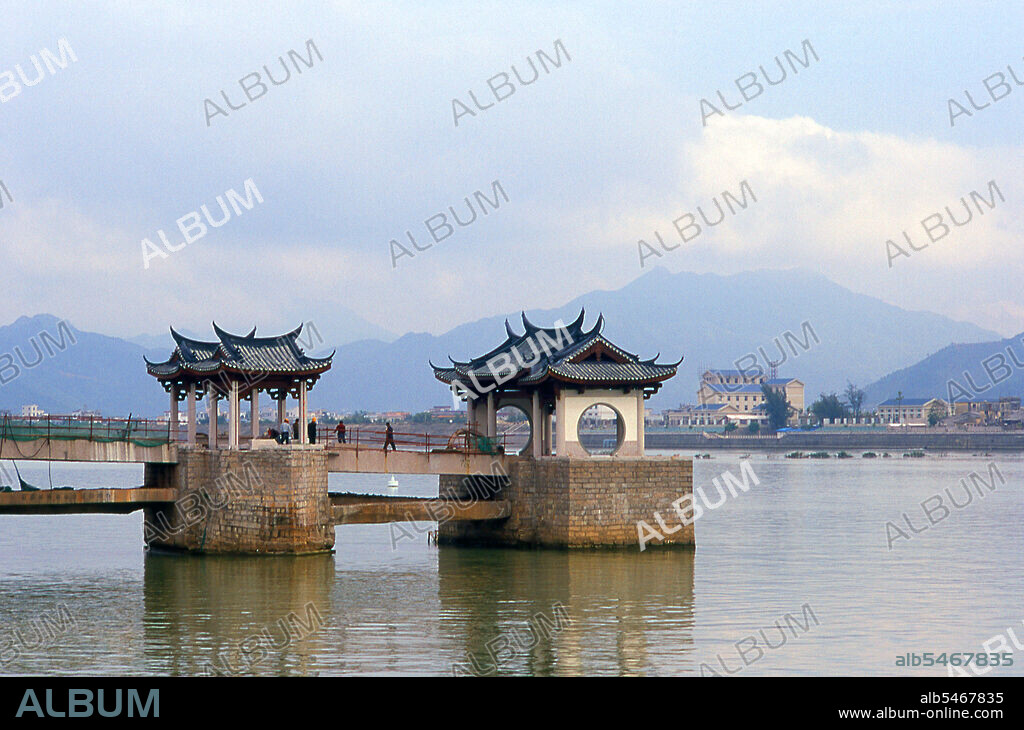alb5467835
The old Guangji (also known as Xiangzi Qiao) Bridge, Chaozhou, Guangdong Province.

|
Añadir a otro lightbox |
|
Añadir a otro lightbox |



¿Ya tienes cuenta? Iniciar sesión
¿No tienes cuenta? Regístrate
Compra esta imagen

Título:
The old Guangji (also known as Xiangzi Qiao) Bridge, Chaozhou, Guangdong Province.
Descripción:
Traducción automática: El Puente Guangji (Guang Ji Qiao; literalmente 'Gran Puente de la Caridad'), también conocido como Puente Xiangzi, es un antiguo puente que cruza el río Han en Chaozhou. El puente es conocido como uno de los cuatro puentes antiguos famosos de China; los otros tres son el Puente Zhaozhou, el Puente Luoyang y el Puente Lugou. El Guangji era originalmente un puente de pontones construido en el año 1170 d. C. durante la dinastía Song del Sur con una longitud de 518 metros (1.699 pies). Posteriormente se inició la construcción de pilas y armazón en ambas márgenes del río sobre el que estaba amarrado, y 200 años más tarde se completó la forma actual del puente, con un tramo flotante sostenido por 18 pantalanes de madera entre dos tramos de vigas. La sección flotante se puede desconectar para el paso de grandes embarcaciones, una innovación que sentó un precedente en la historia de la construcción de puentes. Se cree que Chaozhou se fundó hace más de 1700 años. La ciudad alcanzó su apogeo durante la era Ming y era conocida como un lugar de gran cultura, así como un importante centro comercial y comercial. El dialecto Teochew, por el cual se transmite la cultura Chaozhou, es uno de los dialectos chinos más conservadores porque conserva muchos contrastes con el chino antiguo que se han perdido en algunos de los otros dialectos modernos del chino.
Guangji Bridge (Guang Ji Qiao; literally 'Great Charity Bridge'), also known as Xiangzi Bridge is an ancient bridge that crosses the Han River in Chaozhou. The bridge is renowned as one of China's four famous ancient bridges; the other three are the Zhaozhou Bridge, the Luoyang Bridge and the Lugou Bridge. The Guangji was originally a pontoon bridge built in AD 1170 during the Southern Song Dynasty with a length of 518 metres (1,699 ft). Later, construction of piers and framework started from both banks of the river on which it was moored, and 200 years later the current form of the bridge, with a floating section supported by 18 wooden pontoons between two beamed sections, was completed. The floating section can be disconnected for the passage of large boats, an innovation that set a precedent in bridge-building history. Chaozhou is believed to have been founded more than 1700 years ago. The town reached its zenith during the Ming era and was well known as a place of great culture as well as an important commercial and trading centre. Teochew dialect, by which the Chaozhou culture is conveyed, is one of the most conservative Chinese dialects because it preserves many contrasts from ancient Chinese that have been lost in some of the other modern dialects of Chinese.
Crédito:
Album / Pictures From History/Universal Images Group
Autorizaciones:
Modelo: No - Propiedad: No
¿Preguntas relacionadas con los derechos?
¿Preguntas relacionadas con los derechos?
Tamaño imagen:
5145 x 3404 px | 50.1 MB
Tamaño impresión:
43.6 x 28.8 cm | 17.1 x 11.3 in (300 dpi)
Palabras clave:
ARCHITECTURAL • ARCHITECTURE • ARQUITECTONICA • ARQUITECTONICO • ARQUITECTURA • ASIA • ASIATICO • CHINA • CHINO • CIUDAD ANTIGUA • GUANGDONG • HISTORIA • HISTORICO • PORCELANA
 Pinterest
Pinterest Twitter
Twitter Facebook
Facebook Copiar enlace
Copiar enlace Email
Email
